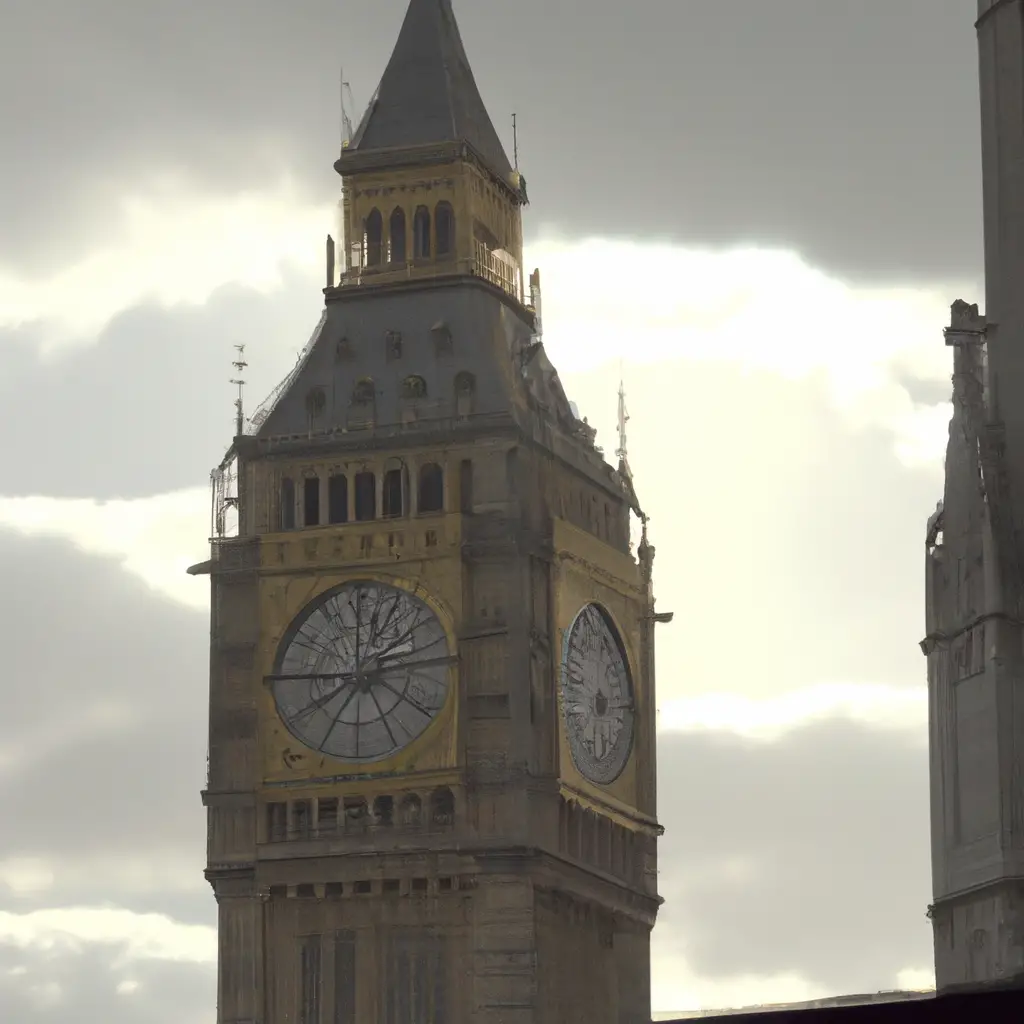Discover the secrets of London’s most famous clock tower.
This article is a comprehensive guide to London’s iconic landmark, Big Ben. It aims to unveil fascinating facts about the clock tower, including its history, construction, and significance to London and the world. Whether you’re a local or a tourist, this guide will provide you with a deeper understanding and appreciation of one of the most recognizable landmarks in the world.
The History of Big Ben: From Concept to Construction
Big Ben is one of the most iconic landmarks in London, and it has become a symbol of the city’s rich history and culture. This magnificent clock tower has been standing tall for over 150 years, and it has witnessed some of the most significant events in British history. In this comprehensive guide, we will unveil some fascinating Big Ben facts and take you on a journey through the history of this iconic landmark.
The concept of Big Ben was first introduced in 1834 when the Palace of Westminster was destroyed by a fire. The government decided to rebuild the palace, and they wanted to include a clock tower that would be visible from all parts of London. The idea was to create a clock tower that would be the largest and most accurate in the world.
The design for the clock tower was created by Charles Barry, a renowned architect, and Augustus Pugin, a talented designer. The tower was designed in the Gothic Revival style, which was popular in the 19th century. The tower was to be 316 feet tall, and it would have a clock face that was 23 feet in diameter.
The construction of the clock tower began in 1843, and it took 13 years to complete. The tower was built using limestone and brick, and it was adorned with intricate carvings and decorations. The clock face was made of opal glass, which allowed the clock to be visible from a distance.
The clock mechanism was designed by Edmund Beckett Denison, a renowned clockmaker. The clock was designed to be accurate to within one second, and it was powered by a pendulum that was 13 feet long. The clock mechanism was so advanced that it was able to adjust itself to changes in temperature and atmospheric pressure.
The bell for the clock tower was cast in 1858, and it was named Big Ben after Sir Benjamin Hall, who was the commissioner of works at the time. The bell weighed 13.5 tons, and it was the largest bell ever cast in Britain. The bell was transported to the tower using a specially designed trolley, and it was hoisted up to the belfry using a steam-powered crane.
The clock tower was officially opened on May 31, 1859, and it quickly became a symbol of British engineering and innovation. The clock tower was also a testament to the resilience of the British people, who had overcome the devastating fire that had destroyed the Palace of Westminster.
Over the years, Big Ben has become an integral part of London’s skyline, and it has been featured in countless movies, TV shows, and books. The clock tower has also become a popular tourist attraction, and visitors from all over the world come to see this magnificent landmark.
In conclusion, the history of Big Ben is a testament to the ingenuity and creativity of the British people. From concept to construction, this iconic landmark has been a symbol of British engineering and innovation. Today, Big Ben continues to inspire and captivate people from all over the world, and it will undoubtedly remain a symbol of London’s rich history and culture for many years to come.
The Mechanics Behind the Clock Tower: How Big Ben Keeps Time
Big Ben is one of the most iconic landmarks in London, and it’s hard to imagine the city’s skyline without it. The clock tower has been a symbol of British culture and history for over 150 years, and it’s still ticking away today. But have you ever wondered how Big Ben keeps time? In this article, we’ll take a closer look at the mechanics behind the clock tower and unveil some fascinating Big Ben facts.
The clock tower, officially known as the Elizabeth Tower, stands at 315 feet tall and is located at the north end of the Palace of Westminster. It was completed in 1859 and has been keeping time ever since. The clock itself is a masterpiece of engineering, with four faces that are each 23 feet in diameter. The hands of the clock are made of copper and are 14 feet long for the minute hand and 9 feet long for the hour hand.
But how does the clock keep time so accurately? The answer lies in the pendulum. The pendulum is a long, thin rod that swings back and forth, and it’s responsible for regulating the clock’s movement. The pendulum is made of a special alloy that expands and contracts with changes in temperature, which helps to keep the clock accurate. The pendulum swings once every two seconds, and it’s connected to the clock’s escapement mechanism, which controls the movement of the clock’s gears.
The clock’s gears are another important part of the mechanism. The gears are responsible for translating the movement of the pendulum into the movement of the clock’s hands. The gears are made of brass and are incredibly precise, with teeth that are cut to within a thousandth of an inch. The gears are also lubricated with a special oil that helps to reduce friction and keep the clock running smoothly.
One of the most fascinating Big Ben facts is that the clock is wound by hand. Every week, a team of clockmakers climbs the 334 steps to the top of the tower to wind the clock. The clock has three weights that hang from the mechanism, and these weights need to be wound up every seven days. The clockmakers use a special key to wind the weights, and it takes about an hour to complete the process.
Another interesting fact about Big Ben is that it’s not actually the name of the clock tower. The name Big Ben actually refers to the bell inside the tower. The bell weighs 13.5 tons and is named after Sir Benjamin Hall, who was the First Commissioner of Works when the bell was cast. The bell is struck every hour to mark the time, and it’s also used to signal important events, such as the start of the New Year.
In conclusion, Big Ben is a fascinating landmark that has captured the imagination of people all over the world. The clock tower’s mechanism is a masterpiece of engineering, with a pendulum, gears, and weights that work together to keep time accurately. The clock is wound by hand every week, and the bell inside the tower is named after Sir Benjamin Hall. These are just a few of the many fascinating Big Ben facts that make this iconic landmark so special.
The Iconic Tower’s Architecture: A Look at the Design and Construction

Big Ben is one of the most iconic landmarks in London, and it is a symbol of the city’s rich history and culture. The tower is a masterpiece of architecture and engineering, and it has been a source of fascination for people from all over the world. In this article, we will take a closer look at the design and construction of this magnificent tower.
The tower was designed by Charles Barry, a prominent architect of the Victorian era. He was commissioned to design a new palace of Westminster after the old one was destroyed by a fire in 1834. Barry’s design was inspired by the Gothic style of architecture, which was popular in the 19th century. He wanted to create a building that would reflect the power and grandeur of the British Empire.
The construction of the tower began in 1843, and it took 13 years to complete. The tower is 96 meters tall, and it is made of brick and stone. The clock faces are made of cast iron, and they are 7 meters in diameter. The tower has four clock faces, one on each side, and they are illuminated at night.
One of the most fascinating facts about the tower is that it was not originally called Big Ben. The name Big Ben actually refers to the bell inside the tower, which weighs 13.5 tons. The bell was cast in 1858, and it was named after Sir Benjamin Hall, who was the commissioner of works at the time. The bell was installed in the tower in 1859, and it has been ringing ever since.
The tower’s architecture is a testament to the skill and creativity of the Victorian architects and engineers. The tower is a perfect example of the Gothic Revival style, which was popular in the 19th century. The tower’s intricate details and ornate decorations are a reflection of the Victorian era’s love of beauty and elegance.
The tower’s construction was a massive undertaking, and it required the work of hundreds of skilled craftsmen and laborers. The tower’s foundation is made of concrete, and it is 15 meters deep. The tower’s walls are made of brick and stone, and they are 3 meters thick at the base. The tower’s clock mechanism is a marvel of engineering, and it is still in use today.
The tower has undergone several renovations and restorations over the years, but its original design and architecture have remained intact. The tower is a symbol of London’s rich history and culture, and it is a testament to the skill and creativity of the Victorian architects and engineers.
In conclusion, Big Ben is a fascinating landmark that has captured the imagination of people from all over the world. Its architecture and design are a testament to the skill and creativity of the Victorian architects and engineers. The tower’s construction was a massive undertaking, and it required the work of hundreds of skilled craftsmen and laborers. The tower is a symbol of London’s rich history and culture, and it is a source of pride for the people of London.
Big Ben’s Role in British History: From World War II to Present Day
Big Ben is one of the most iconic landmarks in London, and it has played a significant role in British history. From World War II to present day, Big Ben has been a symbol of resilience, strength, and unity for the people of London and the entire United Kingdom.
During World War II, Big Ben served as a beacon of hope for the people of London. Despite being damaged during the Blitz, the clock tower continued to chime, reminding Londoners that they were not alone in their struggle. The clock tower also served as a vital communication tool for the British government, as the chimes were used to broadcast important messages to the public.
In the post-war years, Big Ben became a symbol of British pride and resilience. The clock tower was restored to its former glory, and the chimes once again rang out across London. The tower also became a popular tourist attraction, drawing visitors from all over the world who were eager to see the iconic landmark in person.
In more recent years, Big Ben has continued to play an important role in British history. In 2012, the clock tower was renamed the Elizabeth Tower in honor of Queen Elizabeth II’s Diamond Jubilee. The tower has also been the site of numerous protests and demonstrations, as well as celebrations and events.
Despite its age and the challenges it has faced over the years, Big Ben remains a beloved symbol of London and the United Kingdom. The clock tower has become an integral part of the city’s skyline, and its chimes continue to ring out across the city, reminding Londoners of their shared history and heritage.
If you’re planning a trip to London, be sure to include a visit to Big Ben on your itinerary. The clock tower is open to the public for tours, and visitors can climb the 334 steps to the top of the tower for a breathtaking view of the city. You can also hear the famous chimes up close and personal, and learn more about the history and significance of this iconic landmark.
In conclusion, Big Ben has played a vital role in British history, from World War II to present day. The clock tower has served as a symbol of hope, resilience, and unity for the people of London and the entire United Kingdom. Whether you’re a history buff, a tourist, or a local, Big Ben is a must-see attraction that should be on everyone’s bucket list. So why not plan a visit today and discover the fascinating facts and history behind this iconic landmark?
Tourist Attraction or Historical Monument? The Significance of Big Ben
Big Ben is one of the most iconic landmarks in London, and it is a must-see for anyone visiting the city. But what makes this clock tower so special? Is it just a tourist attraction, or is there more to it than meets the eye? In this comprehensive guide, we will explore the fascinating Big Ben facts and uncover the significance of this historical monument.
Firstly, let’s clear up a common misconception. Big Ben is not actually the name of the clock tower, but rather the nickname of the bell inside it. The tower itself is officially known as the Elizabeth Tower, named after Queen Elizabeth II. The bell, on the other hand, is named after Sir Benjamin Hall, the man who oversaw the installation of the bell in 1858.
But why is Big Ben so significant? For starters, it is one of the most accurate and reliable clocks in the world. The clock mechanism was designed by Edmund Beckett Denison and built by the clockmaker Edward John Dent in the mid-19th century. It has been keeping time for over 160 years and has only stopped a handful of times, usually due to maintenance or repairs.
But Big Ben is more than just a clock. It is a symbol of British resilience and determination. During World War II, the tower was hit by bombs several times, but the clock continued to tick. It became a beacon of hope for the people of London, a reminder that even in the darkest of times, life goes on.
Today, Big Ben is one of the most popular tourist attractions in London, with thousands of visitors flocking to see it every day. But it is also a working clock tower, and its chimes can be heard throughout the city. The sound of Big Ben has become synonymous with London, and it is a source of pride for the people who live here.
So, what are some of the other fascinating Big Ben facts? For starters, the clock faces are made of opal glass, which allows the light to shine through and illuminate the numbers. The minute hands are 14 feet long, while the hour hands are 9 feet long. The bell itself weighs over 13 tons and is over 7 feet tall.
But perhaps the most interesting fact about Big Ben is that it is not actually the largest bell in the tower. There are four bells in total, with the largest one weighing over 16 tons. This bell is known as the Great Bell, and it is only rung on special occasions, such as New Year’s Eve.
In conclusion, Big Ben is much more than just a tourist attraction. It is a symbol of British history and resilience, a testament to the ingenuity and craftsmanship of its creators, and a source of pride for the people of London. Whether you are a history buff, a clock enthusiast, or just a curious traveler, a visit to Big Ben is a must. So why not take a stroll along the Thames, gaze up at the towering clock face, and listen to the chimes of one of the most iconic landmarks in the world?
Westminster and Big Ben: Exploring the Heart of London’s Political Center
London is a city that is steeped in history and culture, and one of its most iconic landmarks is the Big Ben. This clock tower, located in the heart of Westminster, is a symbol of London’s political center and has been a fixture of the city’s skyline for over 150 years. In this article, we will explore the fascinating Big Ben facts that make this landmark so special.
The Big Ben is actually the nickname for the Great Bell of the clock tower, which is officially known as the Elizabeth Tower. The tower was completed in 1859 and stands at a height of 315 feet. It was designed by architect Augustus Pugin and engineer Charles Barry, who also designed the Houses of Parliament.
The clock tower is home to four clock faces, each measuring 23 feet in diameter. The clock faces are made up of 312 pieces of opal glass, which allow the clock to be illuminated at night. The clock mechanism itself is a marvel of engineering, with over 3,000 individual parts that work together to keep the clock ticking accurately.
One of the most interesting Big Ben facts is that the clock tower has survived two world wars and numerous bombings. During World War II, the clock tower was hit by a bomb that destroyed the House of Commons chamber, but the tower itself remained standing. The clock continued to keep time throughout the war, despite the damage it sustained.
Another fascinating fact about the Big Ben is that it is not the largest bell in the tower. The Great Bell, which weighs over 13 tons, is actually the second largest bell in the tower. The largest bell is the Great Tom, which weighs over 16 tons and is located in St. Paul’s Cathedral.
Visitors to London can take a tour of the Houses of Parliament and climb the 334 steps to the top of the Elizabeth Tower to see the clock mechanism up close. The tour also offers stunning views of the city from the top of the tower.
The Big Ben has become a symbol of London and is recognized around the world. It has been featured in countless movies and television shows, and is often used to represent the city in marketing campaigns. The clock tower is a testament to the ingenuity and craftsmanship of the Victorian era, and continues to be a source of pride for Londoners.
In conclusion, the Big Ben is a fascinating landmark that has stood the test of time. Its intricate clock mechanism, stunning architecture, and rich history make it a must-see attraction for visitors to London. Whether you are a history buff, an architecture enthusiast, or simply a lover of all things London, the Big Ben is sure to captivate and inspire you. So why not plan a visit to this iconic landmark and discover its many secrets for yourself?
Q&A
1. What is Big Ben?
Big Ben is the nickname for the Great Bell of the clock at the north end of the Palace of Westminster in London.
2. When was Big Ben built?
Big Ben was built in 1859.
3. How tall is Big Ben?
Big Ben is 96 meters tall.
4. What is the significance of the name “Big Ben”?
The name “Big Ben” is believed to have been named after Sir Benjamin Hall, who oversaw the installation of the bell.
5. How often does Big Ben chime?
Big Ben chimes every hour and also chimes every 15 minutes.
6. Can visitors climb to the top of Big Ben?
No, visitors are not allowed to climb to the top of Big Ben.








